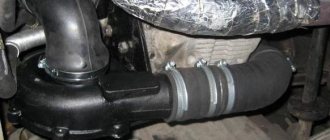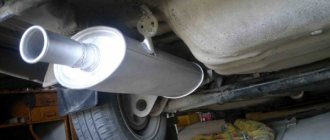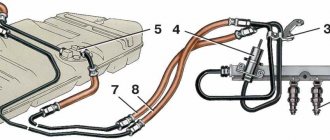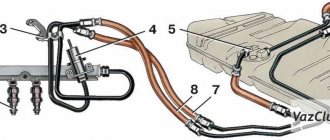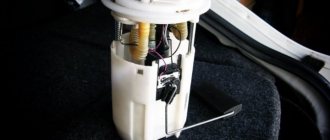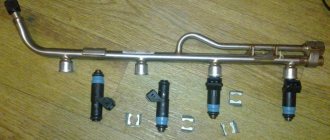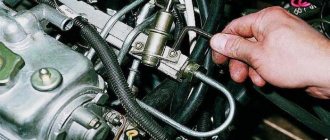Dimensions
Chassis
Fuel
Engine
The most common fuel tank sizes in cars are 40, 50, 60 and 70 liters.
Judging by the volume of the tank, you can tell how big the car is. In the case of a 30 liter tank, we are most likely talking about a small car. 50-60 liters is a sign of a strong middle peasant. And 70 indicates a full-size car. The volume of the fuel tank would be a useless quantity if it were not for fuel consumption. Knowing the average fuel consumption, you can easily calculate how many kilometers a full tank of fuel will last you. On-board computers of modern cars are able to quickly show this information to the driver.
The fuel tank volume of the Lada 4×4 2121 Niva is 42 liters.
Answers (7)
The fuel tank volume of the VAZ Niva 2121 three-door and five-door 2131 is 65 liters.
For those who are especially gifted, I can recommend reading the technical description of the Niva 2121 and other modifications, their tank capacity is 42 liters.
42 liters - tank volume! It can't be 65
VAZ 21312 - (my car...) - has 65 liters.
three-door "shorty" 42 l five-door 2131 "crocodile" 65 l
Based on the gasoline consumption data for 4 trim levels of 2121 Niva (4x4), we calculate gas consumption. Let's calculate how much cheaper gas filling is. How many kilometers will a 2121 Niva travel without refueling?
Power unit
The engine installed on the modern model of the Niva 21213 (214) car was inherited from its Soviet progenitor - the VAZ 2121, and in terms of fluid volumes they are almost identical:
- Liquid cooling system. Filled with antifreeze in an amount of 10.7 liters with a freezing point not higher than -40 ° C. The capacity of the interior heating radiator is also included in this volume.
- Crankcase. Motor oils are poured here, the brand of which depends on the operating conditions. Capacity: 3.75 liters, including oil filter filling.
Costs of 2121 Niva on gasoline
Gasoline costs
| Volume | Transfers | Gasoline type | Gasoline consumption by road type | Price of 1000 km of gasoline, mixed mode | ||
| In the city | On the road | Mixed | ||||
| 1.6 | Mechanics | 92 | 13.0 | 7.0 | 9.0 | |
| 1.6 | Mechanics | 95 | 13.0 | 7.0 | 9.0 | |
| 1.7 | Mechanics | 95 | 11.0 | 8.0 | 9.0 | |
| 1.7 | Mechanics | 92 | 11.0 | 8.0 | 9.5 | |
| Consumption in liters per 100 km. Gasoline price in rubles per liter: 92 - 34.30 rubles, 95 - 37.42 rubles. | ||||||
Blocking the differential mechanism
All-wheel drive does not always guarantee a vehicle's ability to pass on bad roads. In most cases this is not enough. It is only in situations where locking and four-wheel drive work together that the vehicle becomes close to an all-terrain vehicle.
And at the same time, you should always remember that differential locking is a mode intended exclusively for difficult driving conditions. With the help of the blocking system, you can drive through places where other cars cannot pass. It is not recommended to use this mode unless necessary in the city. Otherwise the machine may break down.
Costs of 2121 Niva on gas, difference
Propane consumption, savings
| Volume | Transfers | Gas type | Gas consumption by road type | Refueling for 1000 km, mixed mode | ||||
| In the city | On the road | Mixed | Petrol | Gas | Difference | |||
| 1.6 | Mechanics | CIS | 14.3 | 7.7 | 9.9 | 3 087 ₽ | 1 842 ₽ | |
| 1.6 | Mechanics | CIS | 14.3 | 7.7 | 9.9 | 3 368 ₽ | 1 842 ₽ | |
| 1.7 | Mechanics | CIS | 12.1 | 8.8 | 9.9 | 3 368 ₽ | 1 842 ₽ | |
| 1.7 | Mechanics | CIS | 12.1 | 8.8 | 10.5 | 3 259 ₽ | 1 954 ₽ | |
| LPG - liquefied petroleum gas (propane). Gas price in rubles per liter: CIS - 18.61 rubles. | ||||||||
Compressed natural gas is consumed in city mode at the speed of gasoline, and on the highway it is 20% slower. CNG is cheaper than LPG by one and a half to two rubles per liter.
Gas equipment adjustment
There are quite a few ways to debug HBO, but most of them include the following aspects:
- Compliance of LPG with vehicle standard. Gas equipment on cars with EURO-1,2,3 environmental standards can use any control unit. For the Russian automobile market, the production of such vehicles ended in 2011. The only additional condition for reliable operation of the VAZ-2106, 2110, 21213, 21214 brands can be the use of high-quality radio components. And for models with the EURO-4.5 standard (VAZ-2131, 2123, 2121 and Largus after 2011), it must be equipped with a special program that takes into account road conditions and the fuel used.
- Settings options. When entering data, a difficulty arises with the type of fuel injection of a particular car brand.
VAZ-2131 belongs to cars with pairwise parallel fuel injection
Thus, vehicles with sequential fuel injection include VAZ-21213, 21214, 2123, 2110, 2106, 2121, Largus and Chevrolet, and vehicles with pairwise parallel injection include VAZ-2131.
- Connecting a diagnostic scanner for a gasoline unit. The main goal of debugging gas equipment is to bring the parameters of the engine running on gas to the data obtained from running the engine on gasoline. And this information can only be obtained using a gasoline block scanner. So, for brands 21213 and 21214 there is a slight difference in engine power, so the settings will differ. The deviation in the amount of fuel supplied during fuel correction is displayed as a percentage; a shift from 0 occurs when the injection time changes from the reference values. When debugging, enter the correct coefficient into the system and observe how the car reacts to adjustments.
Examples of savings in Moscow
For example, let's calculate two distances:
- From Red Square to the Moscow Ring Road and back in Moscow 50 km. How much gas does one save per month of such trips?
- From Moscow to Sochi - 1600 km. How much cheaper will it be to fill up with gas?
Savings after installing HBO
| Volume | Transfers | From Red Square to the Moscow Ring Road and back × month | From Moscow to Sochi and back | ||||
| Petrol | Gas | Saving | Petrol | Gas | Saving | ||
| 1.6 | Mechanics | 4 631 ₽ | 2 764 ₽ | 1 867 ₽ | 9 878 ₽ | 5 896 ₽ | 3 983 ₽ |
| 1.6 | Mechanics | 5 052 ₽ | 2 764 ₽ | 2 288 ₽ | 10 777 ₽ | 5 896 ₽ | 4 881 ₽ |
| 1.7 | Mechanics | 5 052 ₽ | 2 764 ₽ | 2 288 ₽ | 10 777 ₽ | 5 896 ₽ | 4 881 ₽ |
| 1.7 | Mechanics | 4 888 ₽ | 2 917 ₽ | 1 971 ₽ | 10 427 ₽ | 6 223 ₽ | 4 204 ₽ |
| Prices for a liter of gasoline and gas: 92 - 34.30 ₽, 95 - 37.42 ₽, CIS - 18.61 ₽. | |||||||
If you spend more than an hour a day driving a VAZ 2121 Niva (4x4), then gas equipment will pay for itself in less than a year. Calculate your monthly and annual savings on your mileage using the savings calculator.
Share with your friends how much they can save:
The principle of installing gas equipment on a VAZ 2131
The installation of gas equipment is complicated, which is also the main disadvantage of the system - it is the need to allocate additional free space for installing the cylinder itself. It acts as a fuel tank. Standard capacity - 90 l. This cylinder is located in the trunk of a car. Naturally, part of it will have to be sacrificed. Another option is to install only 50 liters, which will take up significantly less space. But it will have to be refueled much more often, especially if the car is primarily operated on gas.
You can also place a cylinder in the VAZ 2131 in the muffler area. But it will also have to be partially reworked and an additional beam added. At the same time, of course, the Niva’s ground clearance will decrease, which will negatively affect the SUV’s cross-country ability on a dirt road. Fortunately, there is more than enough space for such a modification in the VAZ 2131. It differs from the regular Niva in that it has an extended wheelbase of 500 mm and the installation of 2 additional doors.
The basis of the HBO kit is:
- gearbox;
- electric gas supply valve;
- electric valve for switching to gasoline;
- mixer (aka mixer).
The most difficult thing is not the installation of gas equipment, but the choice of the location of certain components. This also entails safety and ease of use. For example, it is better to place the gearbox itself on the left side of the hood on a rigid mount. In this case, when hitting various types of bumps, the engine speed will not drop (due to the deflection of the internal diaphragm). A gas valve will be located nearby. For gasoline - on the other side, at the inlet of the carburetor. All that remains is to choose a place for the mixer. It is better to “embed” it in the area of the stove pipes in the VAZ 2131. True, you will still have to buy a tee. But such a system will work flawlessly throughout the entire period of active operation of the Niva.
Mileage without refueling before installing LPG
Let's look at the size of the VAZ 2121 Niva fuel tank (4x4) for gasoline and the most common size of the installed gas cylinder.
Tank VAZA 2121 Niva (4x4), autonomous mileage
| Volume | Transfers | Tank capacity | Refilling the tank | Autonomous mileage on a full gas tank | ||
| In the city | On the road | Mixed | ||||
| 1.6 | Mechanics | 42 l. | ||||
| 1.6 | Mechanics | 42 l. | ||||
| 1.7 | Mechanics | 42 l. | ||||
| 1.7 | Mechanics | 42 l. | ||||
| Gas tank capacity in liters. Gasoline price in rubles per liter: 92 - 34.30 rubles, 95 - 37.42 rubles. | ||||||
Transmission
The Niva 4x4 transmission system has the following filling volumes:
- transfer case - 0.79 l;
- gearbox - 1.6 l;
- rear axle - gearbox - 1.3 l;
- front axle - crankcase - 1.15 l;
- steering column - crankcase - 0.18-0.2 l.
As with the operation of a power unit, under different temperature conditions, transmission units and assemblies are filled with oils of different viscosities, which is reflected in the table:
| Lower limit of ambient temperature, °C | -15 | -25 | -25 | -30 | -40 |
| Upper limit of ambient temperature, °C | +45 | +45 | +35 | +45 | +35 |
| SAE lubricant viscosity grade | 85W-90 | 80W-90 | 80W-85 | 75W-90 | 75W-80 75W-85 |
Autonomous mileage after switching to gas
Autonomous mileage 2121 Niva (4x4) with gas equipment
| Volume | Transfers | Cylinder capacity | Refilling the cylinder | Total autonomous mileage | ||
| Around town | On the road | Mixed | ||||
| 1.6 | Mechanics | 47 l. | ||||
| 1.6 | Mechanics | 47 l. | ||||
| 1.7 | Mechanics | 47 l. | ||||
| 1.7 | Mechanics | 47 l. | ||||
| Price per liter of gas in calculations: CIS - 18.61 ₽. | ||||||
HBO increases the autonomous mileage of the VAZ 2121 Niva 1977...present SUV. doubled. Now there is definitely enough fuel for the longest trips.
Call to ask questions, consult with a specialist or sign up for installation in Moscow (24 hours a day) or write to [email protected]
Certified multi-brand center for installation, maintenance and repair of gas equipment:
Gas Performance Benefits
IN COMBINATION, THESE FACTORS EXTEND THE ENGINE LIFE BY
Gas extends the life of oil and spark plugs and reduces vehicle maintenance costs.
Gas burns a little slower than gasoline, which reduces the load on the piston group and crankshaft, causing the engine to run smoother.
The gas mixes easily with air and fills the cylinders more evenly with a homogeneous mixture, so the engine runs smoother and quieter. The gas mixture burns almost completely, so no carbon deposits form in the pistons, valves and spark plugs.
The octane number of petroleum gas is 103-105, which virtually eliminates detonation of engine parts. This advantage of gas can be especially important for engines with a high compression ratio that consume high-octane (and therefore expensive) gasoline.
The gas does not contain harmful impurities (lead, sulfur), which at the chemical level destroy the combustion chamber parts, catalytic converter and lambda probe.
The gas enters the engine in the vapor phase, so it does not wash away the oil film from the walls and does not dilute the oil in the crankcase.
Savings on fuel are greater than the overpayment on the loan
First payment 0 rub.
Loan term from 1 month
Loan cost 1.6% per month
Loan decision in 15 minutes
Switch to gas and start saving
You will get back the overpaid money for using a two-year loan in the second month of operating the system.
On average, the savings per year when driving on gas is 50,000 rubles.
Save up to 200,000 rubles per year
1 km of mileage on gas is 2 times cheaper than 1 km of mileage on gasoline
Calculate the savings of driving on gas compared to using gasoline
1. Select your car
For example: Peugeot Partner, Citroen Berlingo, Renault Kangoo, VW Caddy
2. Indicate the mileage of your car per year
Having extensive experience in operating gas equipment (this is already the 4th gas-powered car!), I can confidently say that AGTS specialists are the best professionals in converting cars to gas in St. Petersburg. no less than 100 percent. The feeling is super, if you have any doubts, I highly recommend it.
This is the second time I've come here. Hyundai Accent is my second car and, accordingly, my second LPG. Just like the first time, I installed Italian equipment from Lovato. It seems to me that it is the best. At least it’s very easy to set up, which can’t be said about other systems. And stability in operation: the settings are the same as they are. In total, I have been using HBO for 4 years now, and no problems. The most important thing is to regularly visit maintenance and immediately correct errors if something is wrong.
For me, LPG is no longer new - I’ve been driving gas for almost 10 years, and I install it on every new car. I think it’s not worth describing all the delights of the equipment, and a lot of things have already been told without me. I’ll tell you better how the installation of gas equipment in the AGTS went. I made an appointment with the guys a week in advance, arrived at the appointed time, and they were already waiting for me. The box is large and well equipped. Two people are allocated for each car, everything is done quickly and smoothly. I stood there, watching them. It is immediately clear that the team has worked well together. One installs the wiring, the other connects the cylinder. It’s obvious that they know their job here: every car is there – and on the day I arrived, it was sold out. Everyone is busy, there is no unnecessary talk, just business. At this rate, they installed the HBO for me for about two hours, probably, then one worker explained how it works, what is connected to what, etc. That is, in addition to the fact that they quickly installed it, they also gave instructions on how to use it and what to do if something goes wrong. This, it seems to me, is just great for those who are encountering HBO for the first time. And I, an experienced gas driver, was pleased to listen) In general, I recommend it!
contents .. 31 32 ..VAZ-21213 (Niva). Engine power system
2.14.1. Air filter and thermostat GENERAL INFORMATION Engine crankcase ventilation diagram 1 – sealing gasket; 2 – corrugated hose; 3 – thermostat damper handle; 4 – cold air intake; 5 – thermostat; 6 – coupling bolt; 7 – filter cover fastening nut; 8 – air filter cover; 9 – filter cover seal;
| 10 – filter element; 11 – bracket for fastening the filter cover; 12 – exhaust gas manifold; 13 – air filter housing; 14 – spring holder; 15 – heated air intake from the exhaust manifold area |
Removal and installation PERFORMANCE ORDER
1. To remove the air filter, press out the spring holders 14 (see Fig. Air filter and thermostat) and unscrew the nut 7 securing the air filter cover 8. 2. Remove the cover and take out the filter element 10. 3. Unscrew the nuts securing the housing 13 to the carburetor. 4. Remove the filter housing assembly with thermostat 5 by disconnecting the pre-corrugated hose 2. 5. Loosen the tightening bolt 6 and remove the thermostat 5 with cold air intake 4.
| 6. When installing an air filter to reduce intake noise, the filter cover should be installed so that the arrow on the cover is directed as shown in the figure. |
VAZ-21213 (Niva). Fuel tank
GENERAL INFORMATION Fuel tank parts and fuel lines
| 1 – fuel tank; 2 – separator and fuel tank hoses; 3 – separator; 4 – filling pipe; 5 – plug; 6 – hose of the fuel tank and filler pipe; 7 – separator and hatch hose; 8 – fuel level sensor; | 9 – connecting hoses; 10 – seal; 11 – fuel drain line; 12 – fuel line; 13 – hose clamps; 14 – check valve; 15 – carburetor; 16 – fuel pump; 17 – fine fuel filter |
Removal and installation PERFORMANCE ORDER
1. To remove the fuel tank 1 (see Fig. Fuel tank parts and fuel lines), disconnect the ground wire from the battery.
2. Unscrew plug 5 of filler pipe 4 and remove as much gasoline as possible. 3. Remove the rear seat, unscrew the screws securing the right and left trims of the rear wheel arches and remove the trims. 4. Remove the fastening screws and remove the fuel tank compartment cover. 5. Disconnect hoses 9 and electrical wires from fuel level sensor 8, as well as hoses 2 from gasoline vapor separator 3. 6. Remove the mounting bolts and remove the fuel tank. 7. Install the fuel tank in reverse order. Cleaning and control PERFORMANCE ORDER
1. Remove the fuel level sensor.
2. To remove dirt and deposits, rinse the tank with gasoline. 3. Then use a stream of hot water to rinse and steam the tank to remove any remaining gasoline. 4. Carefully inspect the fuel tank along the joint line, make sure there are no leaks, and if necessary, solder the leak with soft solder. Warning:
You can solder only a well-washed fuel tank that does not contain gasoline vapors, which can ignite during soldering.
VAZ-21213 (Niva). Fuel pump
GENERAL INFORMATION
| 1 – discharge pipe; 2 – filter; 3 – body; 4 – suction pipe; 5 – cover; 6 – suction valve; 7 – traction; 8 – manual fuel pumping lever; 7 – separator and hatch hose; 8 – fuel level sensor; | 9 – spring; 10 – eccentric; 11 – balancer; 12 – mechanical fuel pumping lever; 13 – bottom cover; 14 – internal spacer; 15 – external spacer; 16 – discharge valve |
Scheme for monitoring and adjusting the protrusion of the pump drive pusher
| A – gasket with a thickness of 0.27–0.33 mm; B – gasket with a thickness of 0.70–0.80 mm; d – protrusion of the pusher |
The design of the fuel pump is shown in Fig. Fuel pump. Check
Insufficient filling of the carburetor with gasoline may depend on a malfunction of the fuel pump, as well as clogging or damage to the fuel lines.
PERFORMANCE ORDER
1. To find the cause of the malfunction, disconnect the hose from the discharge pipe 1 and use the manual fuel pumping lever 8 to check whether fuel is supplied.
2. If there is no fuel, then disconnect the hose from the suction pipe 4 and check whether a vacuum is created at the inlet of this pipe. 3. If there is a vacuum, then the fuel lines are damaged, and if not, then the fuel pump is faulty. 4. Additionally, the fuel pump can be checked on a bench. Rotating the drive shaft at a frequency of 2000±40 min–1, check the pump flow (should be at least 54 l/h at 20±5° C) and discharge pressure (should be 2.2–3.0 m water column at zero pump flow). 5. If a malfunction is suspected, disassemble the pump and check its parts. Disassembly, cleaning and checking parts PERFORMANCE ORDER
1. To disassemble the pump, unscrew the bolt securing the cover 5, remove the cover and filter 2. 2. Then unscrew the screws securing the housing to the bottom cover, disconnect them, remove the diaphragm assembly and the spring.
3. Wash all parts with gasoline and blow with compressed air. 4. Check the integrity of the pump springs. 5. Check for stuck valves. 6. Check the integrity of the diaphragms. There should be no cracks or hardening on them. 7. After checking, replace any worn or damaged parts with new ones. 8. Always replace the pump gaskets with new ones and lubricate them with a thin layer of lubricant before installation. Installation
To correctly install the fuel pump on the engine, use two of the three gaskets below: A with a thickness of 0.27–0.33 mm;
B 0.70–0.80 mm thick and C 1.10–1.30 mm thick. The pump installation diagram is shown in Fig. Scheme for monitoring and adjusting the protrusion of the pump drive pusher. PERFORMANCE ORDER
1. Install a heat-insulating spacer on the cylinder block, placing gasket A between them, and place gasket B on the plane in contact with the pump. 2. Using tool 67.7834.9506, measure the distance “d” (the minimum amount by which the pusher protrudes, installed cranking the crankshaft slowly). 3. If dimension “d” is within 0.8–1.3 mm, then secure the pump to the engine. 4. If “d” is less than 0.8 mm, replace gasket B with gasket A. 5. If “d” is more than 1.3 mm, replace gasket B with gasket C. 6. Check dimension “d” again and secure the pump to the engine . 7. There must always be a gasket A between the cylinder block and the heat-insulating spacer.
contents .. 31 32 ..
Differential lock on Niva (self-block): bringing the car to perfection
Today we will look at products that can qualitatively improve the Niva transmission. There are a huge variety of them on the market. We will try to clearly and intelligibly answer the question - which self-block is better to install on the Niva.
Content
- What are we dealing with?
- Coefficient, preload and other nuances
- Types of locks on Niva Limited slip self-block (LSD)
- Forced blocking
- How to decide what to install?
What are we dealing with?
What is a differential or as it is sometimes abbreviated as “diff”. Why is it needed?! The Latin word “differentia” and the similar English word “different” are translated into Russian almost identically: “difference” or “different”. There is another definition of differential - planetary gear.
The purpose of this element is to transmit the power of the power unit through rotation without losing it on the axle shaft with the wheels attached to them. The differential causes them to rotate at different speeds depending on driving conditions. Inside a turn, the wheel makes much fewer revolutions than one that goes along a long radius. If in place of the “planetary” there was an ordinary solid axle, the probable parasitic circulation of power would guarantee a decrease in control over the car, loss of traction with asphalt, significant wear of the transmission, incredible fuel consumption, etc. The differential “links” the drive of one axle, removes the “parasitic” phenomenon, without loss of power.
An interwheel differential is present in almost all cars. It is usually located on the drive axle. There may be two or more axes to which the planetary gear distributes the incoming power flow.
Coefficient, preload and other nuances
The Niva 2121 is equipped with permanent all-wheel drive, and therefore, in addition to two inter-wheel differentials, it has a third - an inter-axle differential, distributing the moment between the front and rear.
A regular “free” differential is not always enough for a Niva owner. An SUV is bought to drive like a mother-in-law on different terrain and surfaces: dirt, snow, ice, etc. Often a car ends up with two wheels on a grippy surface and the other side on a slippery texture. In such a situation it is easy to “lose” him. Blocking will allow you not to worry about this.
When choosing a block, you need to take into account two important points - blocking coefficient and preload. The first denotes the ratio of torque on the lagging wheel with good grip and on the leading wheel, which has already lost contact with the road. A free differential has a coefficient of 1. For self-locking ones, it is up to five. That is, the lagging wheel will receive 5 times more torque. This parameter is sometimes indicated in %. For worm gears it is determined by the inclination of the teeth, for disk drives it is determined by the configuration of the friction clutches.
And preload is a certain moment of blocking inside the body of the product even before the moment when it may be required. Mostly in modern self-blocks, preload is created by washers. It can be customized to suit almost any driver's requirements. The washers can be replaced as they wear out, and the differential will continue to serve faithfully for many more years. While the teeth of the “worm” and the clutches of the “disc” design wear out sooner or later, the preload decreases.
True, it is important not to “overdo it” here - excessive preload greatly increases the load on the differential itself and increases the wear of all transmission elements.
Types of blocking on Niva
“Native” differentials can be replaced with a self-locking analogue of increased friction or with a device where the “planetary gear” is locked forcibly. For those who want to install a self-block on a Niva themselves, we will try to thoroughly explain the difference between a worm, screw or disk lock. Let’s evaluate each design that works “from the button.”
Limited slip self-block (LSD)
A limited slip differential or limited slip differential is installed on various sports cars. Many companies have been mass-producing such things in Russia for a long time and in large quantities. It initially has limited slip. This thing independently equalizes angular velocities. It essentially serves as a direct transmission, as if the power is transferred to a single “stick” on which two wheels rotate equally. Can also be installed on a Niva 2124 car.
LSDs are distinguished by the response format - from the occurrence of a difference in angular speeds (disc) or when the torque changes (screw).
Disk lock
There are many options for implementing such a lock, but they all have a common principle - the differential here is equipped with two sets of discs. As soon as slipping occurs, the clutches compress and equalize the angular velocities. The discs are similar to automatic transmission clutches. They do not interfere in any way with the civilian operation of the car. The preload here is created by a spring or conical rings.
The SV-PARTS store offers locking for everyday driving on the Niva for axle shafts with 22 or 24 splines:
This makes it possible to use this product even on the good old Niva, produced by AVTOVAZ, or on its “younger” sister – Chevrolet Niva:

